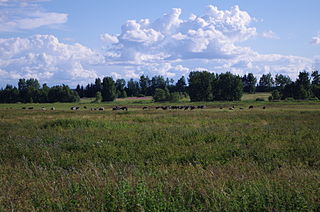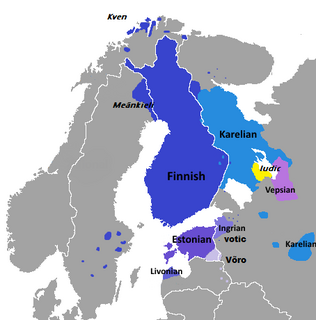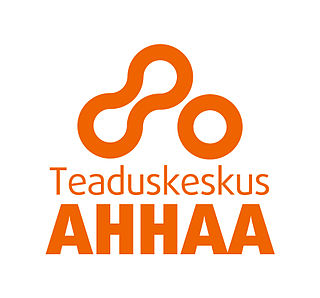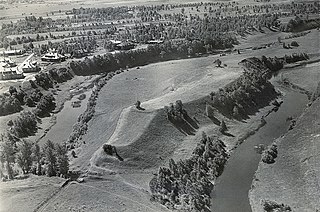
Tartu is the second-largest city in Estonia, after the political and financial capital, Tallinn. It is 186 kilometres southeast of Tallinn and 245 kilometres northeast of Riga, the capital of Latvia. Tartu lies on the Emajõgi river, which connects the two largest lakes in Estonia, Lake Võrtsjärv and Lake Peipus. The city is served by Tartu Airport.
The history of Estonia forms a part of the history of Europe. Humans settled in the region of Estonia near the end of the last glacial era, beginning from around 8500 BC. Before German crusaders invaded in the early 13th century, proto-Estonians of ancient Estonia worshipped spirits of nature. Starting with the Northern Crusades in the Middle Ages, Estonia became a battleground for centuries where Denmark, Germany, Russia, Sweden and Poland fought their many wars over controlling the important geographical position of the country as a gateway between East and West.

Estonians are a Finnic ethnic group native to Estonia who speak the Estonian language and share a common culture and history.

Tartu County is one of 15 counties of Estonia.

Enn Tarto was an Estonian politician who was a leading dissident during the Soviet occupation of Estonia. He was imprisoned from 1956 to 1960, 1962 to 1967, and again from 1983 to 1988 for anti-Soviet activity.

Otepää is a town in Valga County, southern Estonia, it is the administrative centre of Otepää Parish. Otepää is a popular skiing resort, popularly known as the "winter capital" of Estonia. During the 2005–2006 season it became the site for FIS Cross-Country World Cup events.

Ancient Estonia refers to a period covering History of Estonia from the middle of the 8th millennium BC until the conquest and subjugation of the local Finnic tribes in the first quarter of the 13th century during the Teutonic and Danish Northern Crusades.
Jaan Puhvel is an Estonian comparative linguist and comparative mythologist who specializes in Indo-European studies.

The following is an alphabetical list of articles related to the Republic of Estonia.

The Baltic Finnic or Balto-Finnic peoples, also referred to as the Baltic Sea Finns, Baltic Finns, sometimes Western Finns and often simply as the Finnic peoples, are the peoples inhabiting the Baltic Sea region in Northern and Eastern Europe who speak Balto-Finnic languages. They include the Finns, Estonians, Karelians, Veps, Izhorians, Votes, and Livonians. In some cases the Kvens, Ingrians, Tornedalians and speakers of Meänkieli are considered separate from the Finns.

The name of Estonia has complicated origins. It has been connected to Aesti, first mentioned by Tacitus around AD 98. The name's modern geographical meaning comes from Eistland, Estia and Hestia in the medieval Scandinavian sources. Estonians adopted it as endonym in the mid-19th century, previously referring themselves generally as maarahvas, meaning "land people" or "country folk".
Villem Tomiste is an Estonian architect.
Veronika Valk is an Estonian architect.
Sass Henno is an Estonian writer.

Science Centre AHHAA is a science centre in located in Tartu, Estonia, and is currently the largest science centre in the Baltic states. AHHAA was established to promote science and technology using interactive exhibits.

Sakalovapalo burial mounds is an ancient burial ground, a cemetery in Obinitsa village, Setomaa Parish, Võru County in southeastern Estonia. A stone cross used to be located near the burial mounds and the place was important and well known for the people in the region. The stone cross was destroyed during Soviet rule; many other burial mounds were also destroyed during the same period, as the sand from the mound was used on the roads nearby for antiskid treatment. The cross was a donation place, where passersby brought money, buttons, strings of yarn and other things. Red and white ribbons were tied to the bushes near the cross. People in the former times thought that the mounds date back to the Great Northern War or Swedish Rule and told stories of great battles in connection with the mounds. The mounds have been examined in different times by different archaeologists. In 1913, the excavations were done by Russian geologist V. Kreiton. K. Mark, E. Astel, E. Richter, J. Linnus and many others have also done excavations in the mounds. The cemetery might have initially had up to 50 sand mounds. 36 of them have been preserved, 8 of which are extended mounds and 28 are round mounds. The mounds are so far the oldest archaeological relics in Obinitsa area.

Riho Terras is an Estonian politician and a former military officer who is serving as a member of the European Parliament since 1 February 2020. He was the Commander of the Estonian Defence Forces from 2011 to 2018. He was promoted to general in 2017.

The Viking Age in Estonia was a period in the history of Estonia, part of the Viking Age. It was not a unified country at the time, and the area of Ancient Estonia was divided among loosely allied regions. It was preceded by the Bronze and Early Iron Ages in Estonia, during which an agrarian society had developed, the Migration Period, and Pre-Viking Age with the Viking Age itself lasting between 800–1050 AD. It is often considered to be part of the Iron Age period which started around 400 AD and ended around 1200 AD, soon after Estonian Vikings were recorded in the Eric Chronicle to have sacked Sigtuna in 1187.
Kaur Alttoa is an Estonian art historian and cultural historian.

The Valjala Stronghold was a major ringfort on the island of Saaremaa in Estonia. Established in the 12th century, at the time it was the most important Oeselian stronghold. Its surrender in 1227 finalized the crusader conquest of Estonia.














